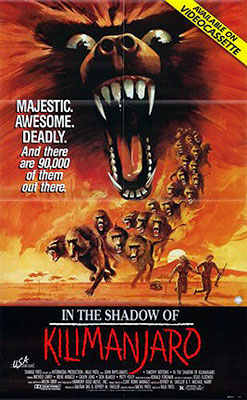 In the Shadow of Kilimanjaro (1986) *Ĺ
In the Shadow of Kilimanjaro (1986) *Ĺ
Welcome to Wasted Potential Night with El Santo. In the Shadow of Kilimanjaro could have been so good. For heavenís sake, itís about thousands of man-eating baboons! When was the last time you saw a man-eating baboon movie? But the film falls flat on its goddamned face from a combination of indifferent direction and a failure to give a not-untalented cast anything good to do.
Supposedly, this is based on a true story. The year is 1984, and it hasnít rained in Kenya for even longer than is generally the case. The drought is causing serious famine throughout the countryside, and is also wreaking havoc on the ecosystem of one of the big national wildlife preserves. The most disturbing effect of the drought, though, is what it is doing to all the baboons. With their normal food supply more or less eliminated, the animals have become aggressively predatory, even to the extent of attacking humans. The first such victim is a young boy, whose trip to the well ends up being his last when he is set upon by a vast baboon army and eaten alive. As the roster of baboon-attack victims lengthens, a white park ranger (Timmothy Bottoms, from What Waits Below and The Sea Serpent) tries fruitlessly to get the authorities to act.
Meanwhile, Chris Tucker (John Rhys-Davies, of Waxwork, who is probably best remembered for playing Indiana Jonesís sidekick in Raiders of the Lost Ark) is having a hard time keeping his mining operation afloat. Apparently, all of the really powerful gear is steam-powered, and steam engines donít work very well in the absence of water. As a consequence, he is siphoning off as much of the local groundwater as he can, which is bad news, considering the fact that his mine is right next to the park full of killer baboons. In essence, his operation is worsening the drought, making the killer apes that much more ferocious. Eventually, the inevitable happens, and the miners are attacked by baboons. A big baboon hunt follows, with apparently satisfactory results, and everybody but the park ranger is convinced that their primate problems are at an end.
But we all know nothing is ever that easy in these movies, and before long, all of the major characters are trapped in a field hospital that is under siege from baboons. Wave after wave of baboons is repelled, but itís kind of like the situation in zombie movies, you know? Just as there are always more zombies somewhere, thereís just no way that our heroes are ever going to run out of baboons. The stalemate continues all night long, but, come morning, the situation is saved by the timely appearance of rain!
This may well be the only movie ever made in which the characters are saved from being eaten alive because it rains. Given that fact and the unlikely choice of animal species to serve as the threat to human life, it is unfortunate that In the Shadow of Kilimanjaro is so badly mishandled. The premise is great, the actors put in some surprisingly good performances given what little they have to work with, and the basic plot is not at all bad, but you could easily be forgiven for believing that the director did not actually realize that he was making a movie. On the whole, it may not completely suck ass, but you will be disappointed if you watch this movie. Anime fans, however, may have a tiny bit of fun trying to spot the background music recycled from the ďRobotechĒ version of ďSuper Dimension Fortress Macross.Ē
Home Alphabetical Index Chronological Index Contact

